|
Other diseases of the rectum (differential diagnoses) and possible consequences of haemorrhoidal disease
Rectal diseases and various diseases of the rectal region:
- skin tags / anal polyps: superficial flaps of skin around the anus (skin tags) or projection of anal mucosa (polyp); if the patient is asymptomatic, treatment is not necessary
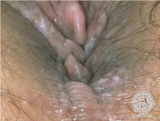
skin tags
|
|
|
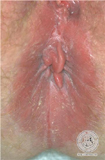
skin tags with anal eczema
|
|
|
- anal venous thrombosis: suddenly occurring, painful swollen nodule in the anal region. Here there are one or, usually, more thromboses in the perianal venous plexus, situated just beneath the skin at the anal margin. Depending on the extent of the thrombosis, there may be marked, very painful swelling. Anal and rectal prolapse: protrusion or projection of the anus or the rectal mucosa (rectum)
- anal fissure: a tear in the skin and the subcutaneous tissue layers in the region of the rectum with ulceration, usually occurring after a hard bowel movement. Persistence for some time (> 6 weeks) may lead to scarring and chronicity.
- cryptitis: anal crypts are physiological mucosal pockets with proctodeal glands (anal “scent glands”) in the region of the dentate line (junction between anal and rectal mucosae) that may become inflamed.
- anal abscess / anal fistula: mature inflammatory infiltrate in the anal region. After the inflammation, fistulae (channels) may form. These usually run from the line of crypts to the exterior and, as a result of constant secretion, may lead to irritation with pruritus and inflammation of the perianal skin.
- pilonidal sinus: coccygeal fistula, subcutaneous abscess and fistula formation situated over the coccyx, predisposing factors being hirsutism, profuse sweating and overweight
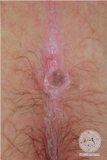
pilonidal sinus
|
|
|
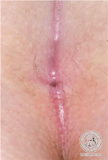
pilonidal sinus
|
|
|
- intestinal parasites: e.g. worm infestations of the intestine/rectum, characterised in particular by marked nocturnal pruritus caused by migration of the worms.

Crohn’s disease with fistula
|
- Crohn’s disease and ulcerative colitis, fistulation: a common feature of both diseases is chronically recurring inflammation of the intestinal mucosa, which may also involve the rectum and may lead to rectal bleeding. In the course of the disease, fistulae may form both in the rectal region (e.g. from the bowel externally to the skin) and within the tissue
|
Skin disorders:
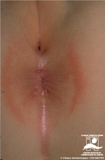
anal eczema
|
|
|
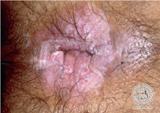
anal eczema
|
- anal eczema: redness and inflammation of the skin in the rectal region of varying clinical extent may be caused by various skin diseases such as allergic, irritant or atopic anal eczema (neurodermatitis)
|
|
- inverse psoriasis: specific form of psoriasis with inflammatory erythema of the intergluteal fold and other skin folds, e.g. axillae or groin

inverse psoriasis
|
|
|
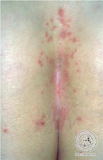
inverse psoriasis
|
|
|

inverse psoriasis
|
|
|

inverse psoriasis
|
|
|
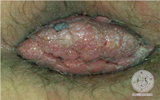
condyloma acuminatum giganteum
|
|
|
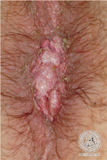
condyloma acuminatum giganteum
|
- condylomata (condyloma acuminatum): also known as genital warts (sexually transmissible infection with human papilloma virus), flesh-coloured/whitish to reddish non-painful nodules and skin growths in the genital region
|
|
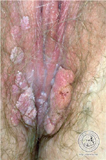
condyloma acuminatum
|
|
|
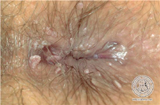
condyloma acuminatum
|
|
|
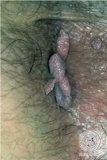
condyloma acuminatum
|
|
|

condyloma acuminatum
|
|
|
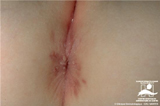
condyloma acuminatum
|
|
|
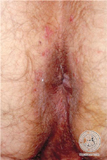
syphilis
|
- infectious diseases: most sexually transmissible diseases such as gonorrhoea (clap), chlamydia or syphilis may also involve the anal mucosa (particularly in homosexual men)
|
- anal herpes simplex: infection of the skin in the perianal region with herpes simplex virus

herpes simplex
|
|
|
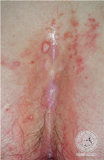
herpes simplex
|
|
|

herpes simplex
|
|
|

herpes simplex
|
|
|
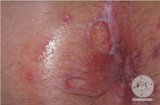
herpes simplex
|
|
|
- tinea corporis: fungal infection of the anal region that may also extend to the groin and the buttocks (see mycoses module)
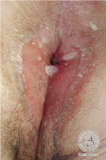
lichen sclerosus
|
|
|
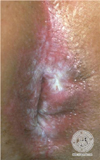
lichen sclerosus
|
|
|

lichen sclerosus
|
- Lichen sclerosus: chronic inflammatory connective tissue disease resulting in whitish atrophy
|
|

lichen planus
|
|
|

lichen planus
|
- Lichen planus: also may involve the mucosae in the oral or genital region and may also occur on the skin
|
|
Malignancies / tumours:

squamous cell carcinoma
|
- anal and rectal carcinoma: malignant disease originating in the epithelium of the anus or the skin, usually nodular
|
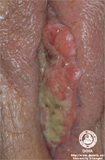
amelanotic malignant melanoma
|
- malignant melanoma: pigmented skin cancer, rarely involves the anus, may also be unpigmented (amelanotic)
|
Pruritus ani:
Itching in the anal region may be caused by various inflammatory and non-inflammatory skin diseases and systemic diseases or may be a symptom thereof. Anal itching occurs, for example, in the context of allergic contact eczema (e.g. toilet paper) but also of atopic dermatitis, irritant contact dermatitis, psoriasis, lichen sclerosus, lichen planus and infectious diseases such as bacterial infections, sexually transmissible infections, fungal, viral or helminthic diseases.
Anal incontinence / stoma:
Incontinence means that defecation can no longer be voluntarily controlled and stopped and passage of faeces or mucus occurs, which may secondarily lead to skin disorders as a result of chronic irritation. Anal incontinence often develops, for example, after surgical procedures with damage to the anal sphincter muscle. In severe cases it is then necessary to create an artificial bowel opening (stoma).
|
